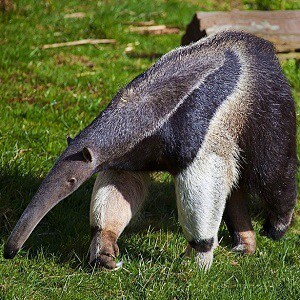Anteaters Vary Greatly in Size
One of the more surprising anteater facts is that these creatures can vary greatly in size. Silky anteaters are the smallest type of anteater, and are as small as squirrels. Giant anteaters, as the name suggests, are much larger. These anteaters can grow up to seven feet in length, measuring from the tip of the nose to the end of the tail.
Anteaters Are Toothless
Of all anteater facts, one of the most curious is the fact that anteaters are actually edentate (toothless) animals. They don’t need teeth because they use their tongues to catch their prey. Their narrow tongues can be up to two feet long. These impressive tongues are covered in small spines and sticky saliva, which allows them to catch ants and termites with ease. Imagine – a carnivore without teeth!
Anteaters Preserve Anthills for Future Meals
As their name states, anteaters eat ants. They catch both ants and termites through the holes that can be found on the top of anthills. However, anteaters are clever; they know that if they destroy an entire anthill, they won’t be able to return to it in the future for another snack. Therefore, anteaters will never destroy an anthill because they need it as a source of food.
Anteaters Can Eat 35,000 Insects a Day without Being Bitten
One of the most astounding anteater facts is that these animals can eat up to 35,000 insects a day. And, if this wasn’t impressive enough, they can do this without being bitten. Anteaters have developed a way of eating that enables them to eat thousands of ants a day without being bitten by these tiny creatures. To do this, anteaters have to eat extremely quickly. During feeding, an anteater can flick its tongue as many as 150 to 160 times per minute to avoid ant bites whilst getting sufficient sustenance. They will also spend only about one minute at an anthill before moving on to find another one.
Anteaters Might Be Carnivores, but They Also Eat Fruit
One of the most intriguing anteater facts is that these animals don’t limit their diets to just ants and insects. Anteaters are also known to eat fruit. Giant Anteaters will eat fruit that has already fallen to the ground. The three other species of anteaters are smaller and will therefore climb trees in order to find fruit to supplement their diet.
The Anteater’s Thick Fur Is a Form of Defense
Anteaters are known for having a strange appearance, part of which is their shaggy fur. However, anteater facts reveal that this is actually a form of protection. The long dense fur protects the anteaters from stings and bites from insects while they hunt for their food.
Anteaters Have Unusual Stomach Acid
Mammals usually produce hydrochloric acid in their stomachs in order to aid digestion. However, an anteater produces formic acid in its stomach for this purpose. This is a special adaptation that is necessary for anteaters because their muscular stomachs need to grind and digest large quantities of ants and termites on a daily basis.
Anteaters’ Sense of Smell Is 40 Times Better than Ours
One of the lesser known anteater facts is that these mammals have very poor eyesight. Because of this, they have to rely on their sense of smell to find food. Their sense of smell is so well developed, that it is 40 times better than a human’s sense of smell.
Anteaters’ Claws Are 4 Inches Long
Anteaters have claws that are an incredible 4 inches long. These claws are non-retractable. Therefore, when anteaters walk, the claws are curled under so that the animal actually walks on its knuckles. While you might think these claws are solely to help them catch ants, they are actually also used for defense. The anteater’s main predators are cougars and jaguars, and their long claws help them defend themselves against these enemies. Anteaters are not aggressive by nature, but if they are cornered, they will rear up on their hind legs, using their tails for balance, and lash out fiercely with their claws.
Anteaters Have a Low Body Temperature
Anteaters have adapted to their environment by having a low body temperature. On average, an anteater’s body temperature measures just 32.7˚ Celsius (approximately 91˚ Fahrenheit). This is much lower than other placental mammals. This low body temperature enables anteaters to conserve a lot of energy whilst they rest, as their bodies only warm up when they become active. This is important because the energy that anteaters consume through their diet only slightly exceeds what they need to expend in order to survive.
Anteaters Sleep for 15 Hours a Day!
One of the more astonishing anteater facts is that these animals sleep for 15 hours a day. However, anteaters sleep lightly. They need to be able to wake up at the slightest sound so that they can protect themselves if necessary. This is especially important because they tend to be solitary animals so don’t have the protection of a group. So much for a ‘cat nap’…
Anteaters Are Solitary Animals
Anteater facts teach us that these mammals are usually solitary animals. Most of the time they will be found on their own. Mating season is the one exception to this rule. This is the one time when anteaters will in fact gather together.
Anteaters Are Generally Very Quiet
Anteaters are usually silent animals. The only exceptions are when male anteaters threaten or fight each other. When threatening another male, an anteater emits a
long drawn out cry that sounds like harrrr. When two males are fighting, they tend to bellow and roar. Other than that, you won’t hear anteaters making any sounds.
An Anteater Pregnancy Lasts for 190 Days
A female anteater is pregnant for 190 days. At the end of her pregnancy, she will give birth to one baby that she will nurse for approximately six months. For the first year, the mother will carry her baby on her back to protect it from predators. After this time, the baby anteater will stay with its mother for another year, or until she becomes pregnant again with her next baby.
Anteaters Have Very Unusual Joints!
The nearest relatives to anteaters are sloths and armadillos. Together, these three animals form the super order known as Xenartha, which is Greek for strange joint. This is because these three mammals are the only animals to have special articulations in the vertebrae of their lower backs. Imagine those x-rays!
The Term Anteater Is Often Misused
The term anteater is often used in relation to animals that aren’t in fact anteaters at all. Aardvarks, numbats, echidnas and pangolins are often incorrectly labeled as anteaters. In fact, although aardvarks are similar to anteaters in terms of their appearance and diet, these two animals are not even related. Aardvarks, pangolins and anteaters look somewhat similar because they have evolved along similar lines, not because they share a common ancestor. So, when it comes to an aardvark or pangolin, it might look like an anteater, and eat like an anteater, but isn’t actually an anteater.
The Giant Anteater Is Classified as Vulnerable
One of the anteater facts pertaining to conservation is the fact that the Giant Anteater is classified as vulnerable. It is estimated that there are only around 5,000 of these creatures still living in the wild. Their numbers are likely to continue to drop because of poaching and the destruction of their natural habitat. The three smaller species of anteaters are not considered to be in any danger at the moment.
Anteaters Frequently Appear in Popular Culture
In recent years, anteaters (especially Giant Anteaters) have started appearing in popular culture. This extends beyond them appearing as major characters in books and television programs. The University of California’s mascot is Peter the Anteater. There is soft toy called Francis the Anteater who has his own Facebook page. An anteater called Sniffles is a character in the Internet series called Happy Tree Friends. Perhaps it’s time that the anteater went to Hollywood!
Anteater Facts – Facts about Anteaters Summary
Anteaters are mammals found in Central and South America. These solitary and quiet animals have many adaptations to help them feed on ants, insects, and even fruit. Anteaters are becoming more prevalent in popular culture, although many people still often mistake other animals for anteaters.
Anteater Facts




No comments:
Post a Comment